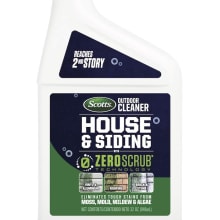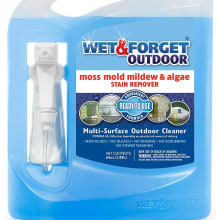 Credit:
Reviewed / Leigh Harrington
Credit:
Reviewed / Leigh Harrington
Products are chosen independently by our editors. Purchases made through our links may earn us a commission.
Have you ever noticed the black, gray, and green stains that suddenly start to accumulate on your house’s vinyl siding exterior? Here’s a tip: There’s nothing sudden about this grime growth, you’re just only noticing it because it’s gotten bad.
When I bought my first house, it was dressed roof to foundation in 30-year-old buttery yellow vinyl siding. Its shade was so pale and sun bleached that you could clearly see it needed—and perhaps had never had—a thorough cleaning. Unfortunately for me, I couldn’t use a pressure washer to blast off the stains, because the siding was too old, gappy, and fragile.
So, imagine my delight when I moved into a new home with brand new vinyl siding in a much more tasteful beige tone. No mold, algae, bird poop, or dinge in sight until three years in.
Believe me when I say it’s my pleasure to help educate you on why and how to clean vinyl siding, and also suggest a few of my favorite products for house washing—that, yes, I did try out—so you can tackle your home’s exterior, too.
Why it’s important to clean your vinyl siding

Wet & Forget outdoor stain remover cleaned up all the nasty green algae and mildew on my siding in about 72 hours.
You’ll want to get in the practice of washing the exterior of your home once per year, as you would any home maintenance task, like cleaning your gutters or sealing your driveway.
A popular time to do so is in the spring, especially in more northern climates where snow, ice, and salt can do a number on your home over the winter. But, the truth is, you can clean your vinyl siding any time of year, as long as you have a mild, sunny day in the forecast.
Many natural factors can lessen the luster of your vinyl siding. There’s pollen, dirt and debris blown onto it by wind and passing traffic. Bird poop and bug goo are other pollutants that can really muck up a pretty house.
If you’ve noticed a neon green crud creeping up your siding, say hello to green algae build-up. It can be pervasive and bold, especially if you’ve gone more than a year between cleanings. Don’t confuse this with gray and yellow-ish mildew, another problematic organic growth that crops up in warm, damp, humid climates.
Dean Davies, a cleaning specialist for the UK-based home cleaning and maintenance company Fantastic Services, says, “Overall, it depends on how quickly your vinyl siding gets dirt and mildew on it. People who live in shady or damp areas might need to clean theirs a bit more often as mildew will just keep popping up.”
Another reason to regularly clean vinyl siding is to protect it from being damaged by household maintenance products that may have splashed onto it while working around the yard, like deck stains, grease or a grease remover, chlorine bleach, and other corrosive solutions.
Davies says, “Vinyl siding is susceptible to discoloring if any insecticides, fertilizers, or herbicides have been used near it. And let’s not forget that it can be accidentally stained when using products such as driveway sealant, motor oil, paint, and caulking.”
Here’s how to clean vinyl siding
There are basically three methods for cleaning vinyl siding: using a soft cloth or soft-bristled brush; using a garden hose; or using a pressure washer.
To pressure wash, or not
Many homeowners will want to take an easy and immediate route for blasting grime into the hereafter. But there’s a lot of speculation around whether or not you should use a pressure washer to clean vinyl siding.
Popular exterior and interior building product brand CertainTeed discourages the use, saying on its website, “We do not recommend power washing vinyl or polymer siding, as it can cause moisture intrusion, damage, and/or discoloration.”
Steve Wade, an exterior siding contractor who installs and repairs vinyl siding in the Pacific Northwest as CEO of his company SFW Construction, says, “Unless you have the right equipment and experience, stay away from power washing, although this is a great way to clean your vinyl. All too often, we hear of homeowners who used overly-powerful power washers and damaged their siding.”
Conversely, the trade association for manufacturers of vinyl and other polymeric siding and suppliers, Vinyl Siding Institute, allows for using a pressure washer, if you’re cautious. “When cleaning, hold the power washer straight at eye level to keep the water on top of the siding where it can clean most effectively,” it recommends on its website. “Do not aim the power washer upward, as water may be driven behind the siding.”
Natalie Barrett, a service quality supervisor for Nifty Cleaning, based in Sydney, Australia, agrees. “Some types of vinyl are not to be treated with pressure water, while other kinds of vinyl can generally handle such cleaning,” she says. “You have to be extra careful with the angling of the water current, and try to shoot at the vinyl from a 90-degree angle.”
How to clean siding without a pressure washer (Soft and gentle is the way to go)

Using a garden hose, a siding cleaner, and a soft bristled brush is a gentle but effective way to remove grunge from your vinyl siding.
Using a garden hose or a soft-bristled brush are both less destructive approaches and are pretty easy to follow.
Many dedicated vinyl house siding cleaners are sold in spray bottles that attach directly to your garden hose. I love this approach because it offers the satisfaction of water pressure while still being gentle on your siding.
Always follow the directions of the cleaning solution. But, for most, the process is as simple as screwing the spray bottle’s hose attachment to a garden hose and controlling a mixed flow of water and cleaning solution from a special nozzle on the bottle.
Because you have the added oomph of water pressure, this method typically allows you to reach the top of a two-story building—about 25 ft.—without ever climbing a ladder.
Homeowners can also opt to clean vinyl siding the old-fashioned way, with soft, microfiber cloths or a long handled, soft-bristled brush and a bucket of cleaning solution. You can also use a germicidal bleach concentrate, which is perhaps the best house wash for vinyl siding.

Microfiber rags do a great job at getting rid of grime.

Reach is all important when you're cleaning the sides of a home.
Alternatively, if you’d rather stick with more natural cleaners, a solution of 30% white vinegar and 70% water can be used as a siding cleaner instead of bleach. However, while vinegar does work, it might require a little more muscle than bleach for particularly stubborn stains.

Use this powerful germicidal cleaner to scrub away mold.

Sure it's edible, but vinegar also makes an excellent cleaner.
Again, follow the directions on the bottle of cleaning solution, but typically, you dilute the concentrated formula with water, and then wipe down your vinyl siding. Some solutions want you to wash the siding dry, and some instruct you to pre-rinse the house’s exterior.
Work in small sections, starting at the bottom of the section and working up, which prevents streaking. You’ll also want to rinse away the cleaning solution, from top to bottom, before it has a chance to dry on your siding. Otherwise, you may incur a noticeable residue, as I did, when I let it dry just to see what would happen.
Wade cautions, “Do not use hard pressure when scrubbing due to the possibility of cracking and pieces becoming loose.”
Pro tip: Plants do not like vinyl siding cleaning solutions. Any harsh chemicals that will remove mold from siding could hurt your garden.
To prevent killing your shrubs, bushes, and flowers, water your garden ahead of time. Having pre-saturated soil prevents the cleaning solution from soaking in. You can also cover plants with a tarp.
What’s the best vinyl siding cleaner for you?

We tried out a half dozen top-selling vinyl siding cleaners to see how they performed—and they all tackled our grime with ease.
When it comes to figuring out the best vinyl siding cleaner, homeowners have to assess what makes sense for their house, location, and agility.
If you want to try the garden hose spray bottle method, which is my favorite, I can suggest a few great options.
Both Scotts House & Siding Zero Scrub outdoor cleaner and Wet & Forget Outdoor moss, mold, mildew and algae stain remover clear up the mold and mildew within 72 hours without a single scrub from you. Neon green mildew goes the way of the dodo completely, but you may notice a slight residue that remains. And for little effort large reward I loved these both when I tried them.

Kill mold without tearing your rotator cuff.

This spray will do the work for you.
For people who need immediate gratification and to check this item off their to-do list: You’ll want to use Scotts Outdoor Cleaner 51080.

Make quick work of mold and moss with this siding cleaner.
It offers that same easy hose application as its sister no-scrub product, but it differs in that you actually do have to scrub and rinse the siding after application. The result is the best in the shortest amount of time. If your house is more than one story tall, however, this option may be a no-go.
Personally, I wouldn't want to be hanging off a ladder 25 feet off the ground, scrubbing siding. I'm ambitious only to a point.
You can also DIY a solution for house washing with regular items found in your shed or utility room.
For routine maintenance, Wade says, “It's best to use warm, soapy water (dish or laundry soap). Hot water can damage the siding. But, for extensive residue, mix a general-purpose cleaner or one-part Simple Green Oxy outdoor cleaner and 15-parts water (about one cup per gallon of water) and load in a power washer. Spray the home on a light setting with a wide-angle nozzle to prevent damage.”

Load your power washer with Simple Green for routine cleaning.


